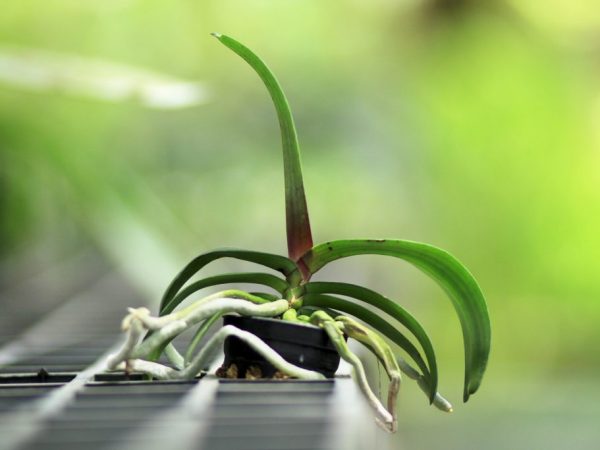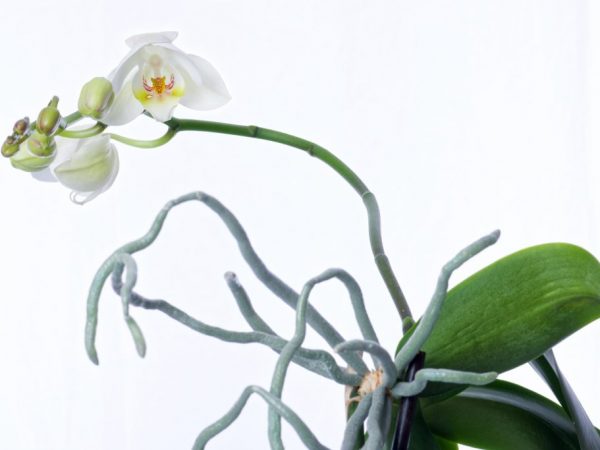Why do the roots of an orchid dry
If the roots of the phalaenopsis orchid dry, then this is a sign of improper care or inappropriate growing conditions. You can correct the situation by finding out the reason for the drying out of the flowers.

Why do the roots of an orchid dry
Drying reasons
Orchid roots dry out for the following reasons:
- violation of the water regime;
- poor air humidity in the room;
- plant burns with hard water or chemical fertilizers;
- diseases and pests;
- physical damage.
Often, the roots begin to dry immediately after the newly purchased plant is planted. The reason for this is poor transportation. A small crack or scratch can cause drying.
Lack or excess of water
The main reason why the phalaenopsis orchid begins to dry out is the insufficient amount of moisture introduced. This problem is typical for regions with high ambient temperatures. To restore the plant, you need to increase the amount of water when watering.
The second reason for drying is excess moisture. Although there is a lot of water, an excess amount causes rot and the development of fungal diseases, because of which the roots dry out and die. To restore, the amount of moisture should be reduced and watering should be reduced to 1 time per week, as well as care should be monitored.
Other reasons

Don't apply too much fertilizer
If you apply too much amount of mineral fertilizers, then there is a risk of provoking a chemical burn, which causes drying. A similar problem arises when using hard unfiltered water for irrigation.
With an excess intake of salts and minerals, they accumulate on the surface of the plant and cause drying. The problem is diagnosed by the presence of white bloom at the base of the plant. Also, during hot periods, salt evaporates and settles on flowers and leaves.
If the roots are very dry, then you need to completely replace the substrate, and place the plant for several hours in a container with warm water. It is also required to normalize the fertilization regime and control the water quality. It is better to use only settled moisture, melted snow or chilled boiling water. It is also useful to add ash to the water, which softens its composition.
Extra roots
The appearance of a large number of air outlets indicates the following problems:
- lack of light;
- small amount of moisture;
- lack of oxygen;
- plant age.
New aerial outgrowths are trying to find a new source of moisture or light. It is also possible to form roots for dumping old ones or to avoid rotting from excess moisture.
If the problem is not resolved in a timely manner, the roots will cause drying. It is required to eliminate the cause of their appearance and cut off most of the processes, and treat the cut with a biostimulator. If the problem disappears, the remaining air outlets will disappear on their own.
Plant healing
To revive dried orchid roots, remove the plant from the pot and clean the roots. Dried segments of the root system are removed.They are determined by tactile sensations - healthy roots are solid, and dead ones, on the contrary. It is difficult to determine by color, because in some varieties of orchids they are different and change color depending on the environment. Also, a water bath is used for diagnostics.
Root cut sites are treated with biostimulants. For this, it is better to use phytospirin. It also prevents mold and rot. It is required to prepare a solution of 500 ml of water and 10 drops of the product and keep the plant in it for 4 hours. Next, the wounds are treated with cinnamon and activated carbon.
The final step is to prepare a warm soft water bath. Better to use a glass or ceramic container. The plant is placed in a bath daily for 2-3 hours. Then the orchid is dried and placed over the container. The procedures are repeated until new strong roots appear, and then planted in a pot with a new substrate.
Restoring a Weak Plant
To cure an orchid at home, you need to perform the following procedures:
- remove the peduncle;
- prepare a container with a special substrate;
- plant a plant;
- leave the seedling in a warm place without drafts;
- grow as a new plant.
Conclusion
To prevent the roots of phalaenopsis from drying out, you must follow the rules for caring for the plant. It is also necessary to regularly inspect the roots for the presence of fungus, rot and harmful insects.
In order not to accidentally cut off a healthy root that looks like dried out, you need to place the plant in a container of water. The normal process will quickly straighten, while the dead will remain dark and shriveled.


